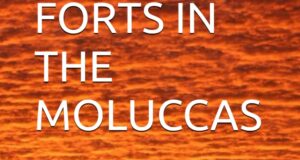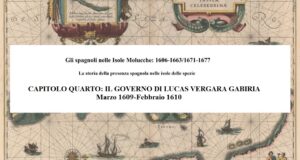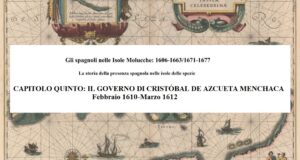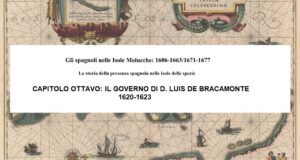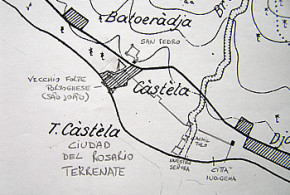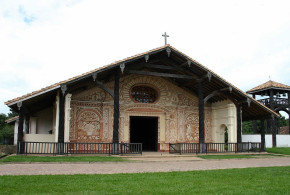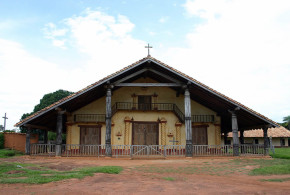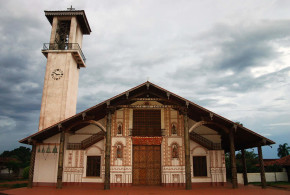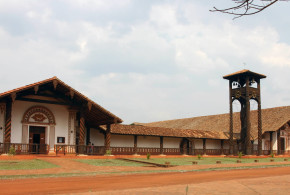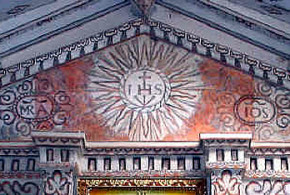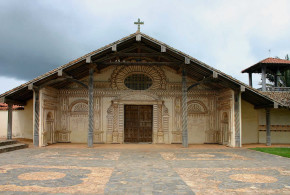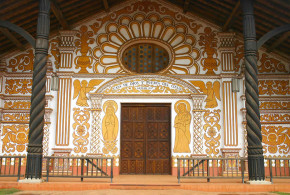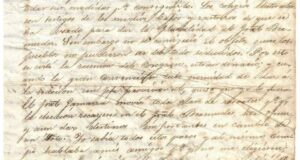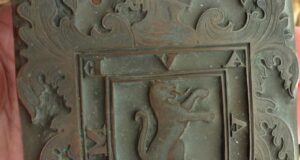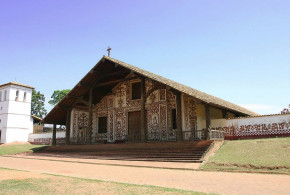This post is also available in:
![]() Italiano
Italiano
Written by Marco Ramerini 2000-2007/2023
5.2 – FUERTE DE LOS PORTUGUESES
Fuerte de los Portuguéses (Fortaleza dos Reis Magos): (Current name: ?)
CHRONOLOGY: Portuguese: January 6, 1578 – May 19, 1605
Captured by the Dutch on 19 May 1605 then abandoned.
Spanish: c.1609 – 9 July 1613
Dutch: 9 July 1613- August/November (?) 1613
This is the fort built in Tidore by the Portuguese in 1578, after the loss of the fortress of Ternate ‘...de haver hecho los nuestros otra fortaleza en la isla de Tidore, dos leguas de la otra de Ternate que se perdió…’ 1. The fort was built at the request of the king of Tidore, who in doing so intended to counterbalance the overwhelming power of his rival the sultan of Ternate. The Portuguese were happy to accept the offer, even if in Tidore they were mainly guests and never recovered the dominating position they had had in previous years when they controlled the island of Ternate.
The construction of this fort was begun on January 6, 1578, by Sancho de Vasconcellos, and for this reason it was called ‘Fortaleza dos Reis Magos’. The fort ‘… de los portugueses que estaba en el lugar grande del Rey de Tidore’ 2, it was located north of Soasiu at a distance ranging between 750 meters3 and 1500 meters4 according to the testimonies. The new fortress was square in shape with sides ‘…por cada parte de 30 braças’5, on two opposite corners two bulwarks had been built, this fortress is described as ‘…muy fraca e que facilmente se pode tomar’, the building was of stone ‘emsonsa’.
In the vicinity of the fort, a small town soon developed, inhabited by Portuguese casados with their families, by Spanish soldiers (they were soldiers from the expeditions of Sarmiento and Morón who had remained in Tidore), merchants and natives: ‘Está a povoação dos portugheses posta a lungo da praia, em hum sitio muito aprazivel e sadio. Terá acerca de 60 casados portugheses com suas molheres e cincoenta soldados castilhanos, afora dos mercadores que vem e vão com a nao da carreira e outra gente da terra.’ In the village the Jesuits had a plot of land that measured 70 ‘braças‘ in length and 65 ‘braças‘ in width, here in 1588 a church was built which, considering also the chapel, was 15 ‘braças‘ long and 7 ‘braças‘ wide. Together with the church, the Jesuits had a house with a warehouse, a refectory and a home for the boys. All these buildings were made of wood and were in a great location: ‘…da levante tem o mar e atrás tem vista do gune (the volcano of Tidore), e por todas as partes tem vista muito aprazivel.’6 Throughout the period of Portuguese control (1578-1605), the village inhabited by the Portuguese casados was never protected by walls, in fact during the Dutch attack of 1605 the women and children were forced to take refuge inside the fort of the king of Tidore, the Portuguese fort being too small to accommodate all of them. The reason why a wall or at least a ‘tranqueira‘ was never built around the village is to be found in the opposition to this by the king of Tidore.7
An ambiguous description of the Portuguese fortress is given to us by “Livro das cidades e fortalezas que a coroa de Portugal tem nas partes da India …” written in 1582: the fortress is described as small and of little importance, its ramparts were of ‘pedra e barro‘, according to this testimony it was built‘…em hum outeiro alto (que chamão de Cachilduquo) que fica senhoreando a cidade principal da Ilha’ where the king of the island resided, the king’s city was located approx ‘hum tiro de berço’ (a shot “de berço” corresponds to a distance between 300 m. and 400 m.) from the fortress. Here it seems that the source makes some confusion with the fort of the King of Tidore, indicating the Portuguese fort located on an “outeiro alto” which dominated the main city of the island, while in fact all the other testimonies indicate precisely in lack of commanding position over the city the weak point of the Portuguese fortress at Tidore.8
The Portuguese fort of Tidore remained the last bastion of the Portuguese presence in the Moluccas, it was attacked in May 1605 by a flotilla of Dutch ships (5 large ships and 4 “pataccos”) commanded by Vice-Admiral Cornelis Bastiaensz, with a total of slightly more of 200 men, according to the Jesuit Luís Fernandes. The Dutch vessels, which were part of Admiral Steven van der Hagen’s flotilla, arrived at Tidore on May 2, 1605, where they anchored near the tip of ‘Saconora’9. A few days later, on May 5, they had a hard fight with two Portuguese galleons10 which were at anchor in the port of Tidore, the boats had been positioned by the Portuguese in front of the city of Tidore where two trenches (‘twee schansen‘) had been built to defend the ships, the clash lasted about an hour (two hours according to the Jesuit Luís Fernandes) and ended with the capture of both Portuguese boats, to which the Dutch, in the following days, after taking the artillery, set fire. Dutch losses in this engagement were three killed and seventeen wounded, while the loot was only seven artillery pieces. On the Portuguese side, there were two dead and some wounded.
Despite the defeat in this first engagement, the Portuguese of the fortress of Tidore, commanded by Pedro Álvares de Abreu, did not surrender at the sight of the ships (unlike what had happened shortly before at Ambon) and at the ease with which the Dutch had destroyed the two galleons, but forced the Dutch to fight. About a month before the arrival of the Dutch ships, the Portuguese had learned, from an English ship (that of Henry Middleton), the news of the imminent possible arrival of the enemy fleet and had immediately set about reinforcing the fortress, in whose work the priests, women and children had also participated.
Despite the efforts, the fortress was poorly armed, it had only 11 pieces of artillery and of these six or seven could not reach the place where they had to stay, moreover the number of defenders was also small, about seventy men of which only thirty who could fight well, tells us the Jesuit Luís Fernandes, who was one of the survivors. The contrast is stark with the firepower of the Dutch fleet which had about 120 artillery pieces. In addition to this overwhelming superiority, the Dutch called the sultan of Ternate to their aid and guaranteed the neutrality of the king of Tidore who holed up in his fortress to observe the events.
On May 14, 150 Dutch soldiers, commanded by Captain Jansz-Mol (captain of the ship ‘de Gelderland‘) and Captain la Derre (van der Perre or van de Verre), landed in the vicinity of the fort, where they attacked and burned two villages, one located north of the fort, the other south which belonged to the Portuguese. The sultan of Ternate, who had arrived on 16 May with fourteen ‘caracoras‘ and about 2,000 men, landed 500 of his soldiers and according to Dutch sources, he awaited the development of events (in the testimony of the Jesuit Luís Fernandes, however, the Ternatese took an active part in the attack, building the trench and participating in the final assault).
In the meantime, the Dutch, to the north of the fort, had built a trench (according to the Jesuit Luís Fernandes it was the Ternatese who built the ‘tranqueira‘), made up of barrels filled with earth, from which they began to canonize the fort, which was also under the constant fire of the ships’ artillery. Beginning on the morning of May 17, the fortress was intensely bombarded for two days, but despite the massive bombardment, the Portuguese lost no men and had only one lightly wounded in these first two days of bombardment.
On the third day, May 19, 1605, the Dutch, after having brought the artillery closer to the fort at night and having arranged all the boats in front of the fortress, began from midnight to bombard the fort even more intensely.
At the same time the troops began to disembark and positioned themselves behind the battery, then, at dawn, noticing a breach in the walls (the breach was located ‘debaixo do baluarte do capitão‘ according to the testimony of the Jesuit Luís Fernandes) they attempted to enter in the fort. Jansz-Mol (Jan Janszen Moll) at the head of his soldiers impetuously attacked the side of the walls where the breach was, and Mol with seven other soldiers managed to enter the fort, but the defenders, who had taken refuge in the towers of the powder magazines, did not lose heart and counterattacked harshly managing to repel the Dutch and even chased them towards the trench.
But at this point bad luck raged against the Portuguese, in fact an artillery shot fired from the Dutch ship ‘de Gelderland‘ hit the powder magazine tower, just at the moment when the Portuguese were shouting victory, the tower blew up and with it also the sixty men who were in its defense, the huge explosion caused the death of many defenders and a huge gash in the walls of the fort. The Dutch revived by the incident went back to the counterattack and the Portuguese soldiers were forced to abandon the fort taking refuge in the city of the King of Tidore ‘lugar de Tidor‘.
The Ternatese who until then had limited themselves to observing the situation, according to the version reported by the Dutch, once they saw the outcome of the battle began to loot the houses. All the battle for the fort cost the Dutch only two killed and eight wounded, while the Portuguese had seventy-three dead and 13 wounded according to Dutch sources, according to the Jesuit Luís Fernandes the Portuguese dead caused by the explosion of the powder magazine were about thirty.
The families of the Portuguese who resided in Tidore, and who had taken refuge in a ‘casa fuerte’11 located in an inaccessible place on a high mountain not far from the fortress, after the surrender of the few remaining Portuguese soldiers, they decided to follow their fate and together with them were exiled from Tidore. The Dutch gave the survivors (according to the Dutch version about 500 people, among them also the Jesuit Luís Fernandes, superior of the Jesuit mission of the Moluccas; 400 people according to the Jesuit Luís Fernandes) four boats plus a boat offered by the King of Tidore, with which they moved, via Siau, to Oton in the Panay Island (Philippines) where they arrived between the end of June and the first days of July 1605. The Portuguese fort of Tidore was conquered by the Dutch on May 19, 1605.12
After the explosion of the powder magazine, the fort must have been in very bad shape, in fact the Dutch did not rebuild it and did not occupy it with a garrison, however this seems to be mainly due to the small number of troops who were on board the ships of the vice-admiral Cornelis Bastiaensz. The Dutch kept only one farm in Tidore, in fact in 1606, the Spaniards who passed through Tidore before attacking Ternate, captured a farmer and three sailors in the Dutch farm and also found 2,000 ducats, some merchandise and many weapons.13
According to what declared, at the time of his capture by the Spanish in 1606, the factor of Tidore, Jacome Joan, the king of Tidore in the aftermath of the capture of the Portuguese fort had sworn allegiance to the Dutch and requested their protection, offering them the construction of a fort where they could station the troops for the defense of the island. But since the fleet commander (Cornieles Bastian, Cornelis Bastiaansz), who had captured the Portuguese fort, did not have enough men to leave to garrison the island, the offer was declined. Then at the specific request of the king it was decided to leave only a few Dutch on a farm to trade. The king of Tidore also undertook to defend the Dutch who remained on the island and to guarantee the Dutch the exclusivity on the clove trade.14
According to the information collected by Esquivel in 1605 upon his arrival in the Philippines, the fort of Tidore was not the most robust and powerful ‘… me dizen is bien debil‘, despite this he judged it difficult for a fleet of only 5 ships to conquer it. Esquivel, as we have seen, was wrong in this judgment (even if the Dutch had been very lucky in hitting the powder magazine of the fort at the crucial moment), but he rightly expressed the opinion that even if the Dutch had succeeded in conquering the fort they could not have occupied it with a large garrison, so when Acuña’s expedition arrived it would have been easily reconquerable.15
The remains of the Portuguese fort must not have attracted the attention of Acuña and Esquivel either since after the conquest of Ternate, the orders left to Esquivel by Acuña were to build a new Spanish fort on the island of Tidore. In Esquivel’s description of the site chosen for the construction of this new fortress, a mention is also made of the old Portuguese fort: the site chosen for the new fort was very close to the king’s city (‘lugar del Rey‘) and about a quarter of a league from where was the fort which was burned ‘…cosa de un quarto de legua de donde antes estaba, la que se boló y en la misma parte que dicen que Hurtado de Mendoça quizo hacerla quando estuvo aquí‘. The fortress ‘que se boló‘ was undoubtedly the old fort of the Portuguese, conquered by the Dutch on 19 May 1605, thanks to the explosion of the powder magazine of the fort.16
Subsequent Dutch reports also confirm that the fort had to be abandoned between 1606 and 1608: the Portuguese fort is mentioned in the description of the defenses of the cities of Tidore made in the report of Admiral Matalieff (1607), in fact to protect the north side of the city, at the distance of a big cannon shot (a cannon shot is approximately between 600 m. and 1000 m.) was the old Portuguese fort. In front of the city in the sea there was a coral reef that could only be crossed at high tide, it started from the south of the city and reached the Portuguese fort.17
In June 1608, a new Dutch report describing the state of defense of the city of Tidore, indicates that due to the presence of the coral reef in front of the city, the only suitable place for a landing of troops was in front of the old and dilapidated Portuguese fort which was located a ‘gootelincx shoot‘ from the city, here in fact the coral reef ended and made landing possible. The old fort does not seem to have been maintained by the Spanish in a state of defence, it is in fact described as dilapidated, but the surrounding land was covered by bush and this allowed the Spanish to try to repel the landing, furthermore the route to be followed along the beach to reaching the city was feasible only at low tide, the path leading to the city was narrow and blocked by bamboo palisades which made it difficult for troops to advance and which could slow down the march of the Dutch soldiers.18 All these difficulties dissuaded the Dutch from attempting an attack on Tidore.
The fact that the fort was located where the landing point closest to the city of Tidore was, still made its control of paramount importance to the city’s defences. In 1609, the governor Vergara aware of the importance of the Portuguese fort decided to rebuild it ‘… hiço de nuebo los fuertes de Marieco el fuerte vejo de portugueses’ ‘Que fortifico en la isla de Tidore el lugar de Marieco y el fuerte que los olandeses ganaron a los portugueses el ano de seiçientos y çinco’.19
Even if the subsequent testimony of Azcueta seems to deny that any work was actually done to this fort during the few months (March 1609-February 1610) of Vergara’s rule. In fact, the Portuguese fort is mentioned again, in 1610, in a report drawn up by the governor of Ternate, Cristobal de Azcueta: the governor Azcueta in the first months of his government in Ternate visited the island of Tidore, where, in addition to locating the site where to build the new Spanish fortress, he also visited the place where the remains of the old Portuguese fortress were (‘la fuerca vieja de los Portuguesses que estaua por el suelo perdida‘), he, in agreement with his captains, decided to partially restore the fort, due to the good port he had (‘… por el buen puerto que tiene, y no auello mexor en esta isla de Tidoro …’).
Thus the old terreplein was used where a parapet was erected, and where 16 soldiers with 3 artillery pieces were stationed. Azcueta wisely paid no heed to the king of Tidore and his ‘cachiles‘, who asked the Spaniards to fortify the only Portuguese fort and not to build a new one above their city. In fact Azcueta judged the old fort too far from the king’s city to be able to defend and control it and so it was that, as we will see, he decided to build the fort of Tahula.20 Confirming the partial restoration of the old fort by the Spanish, a Dutch report from 1610 informs us that the old Portuguese fort had a garrison of 13 Spanish soldiers and 2 cannons had been mounted in the fort.21
In the spring of 1613, immediately after the Dutch conquest of Marieco, work was feverish to bring this fort to a minimal state of defence. It is still considered very important in the defenses of the city of Tidore, for this reason the king of Tidore asked de Silva to order that this fort be immediately restored and reinforced.22 De Silva immediately gave the order that it be fortified, for this purpose he placed the works for the fortification of the ‘fuerte de los portuguéses‘ under the direct control of the Prince of Tidore. While he put under the control of the King the works of the other fort that he judged indispensable in the defense works of the city, the fort of Tahula (‘… la fortificacion de arriba’). He also ordered to abandon any other fortification work along the shore (probably this was the ‘baluarte del Principe‘), since on that side there was the coral reef, which prevented any attempt to disembark. To speed up the work all the stonecutters present in Ternate were sent to Tidore, the construction of some ovens to bake the bricks was also ordered both in Tahula and in the ‘fuerte de los portuguéses’.23
A hint of the Portuguese fort and its artillery equipment a few months before the Dutch attack is offered to us in the report left by the English captain John Saris, who visited Tidore in April 1613. In fact, after the British had stopped in the vicinity of the fort of Tohula, in the evening they anchored with the assistance of the chief of the galleys Gomez about a league and a half away from the fort, here the next morning the British realized they were in the vicinity of a battery of 8 guns which they had not noticed during the night and which was evidently what remained of the Portuguese fort after the fortification work carried out by the Spanish.24
In June 1613, the king of Tidore changed his opinion on the usefulness of restoring the Portuguese fort, in fact in a letter to Geronimo de Silva he stated that he had been to see the fort, which is described as not very robust ‘… tan flaco por ser de piedra sobre piedra‘, who greatly doubted its usefulness in the event of an attack, he suggested to de Silva, on the advice of his ‘cachiles‘, that he dismantle it and concentrate all efforts on the defenses of the city of Tidore.25 However, Geronimo de Silva’s answer left no room for discussion, he considered the Portuguese fort to be of fundamental importance for the city’s defenses and this for several reasons: the first for the great ‘opinion‘ that the fort had, the second for being been defended many other times from enemy attacks with fewer soldiers than those who were present at the moment, finally it was de Silva’s opinion, that the Dutch would never be so foolish as to attack and place their troops between two forts where there were Spanish soldiers. The governor ordered to continue with the fortification work of the fort and to clear the area around the fort of the bush for the length of an arquebus shot. He was convinced that in the event of an attack on Tidore, the Dutch would have to land their troops near the Portuguese fort.26
It was in fact this fort, the one attacked by Pieter Both in July 1613 with a fleet of 12 ships and under the command of 700-800 soldiers, including 50 Japanese mercenaries hired by Hendick Brouwer and with a fleet of 40 ‘caracoas‘ and about 2000 Ternatese.
On July 7, at 5 in the afternoon, 13 Dutch ships sailed from Malayo to Tidore, one vessel remained to guard the fort of Marieco el Grande, which had been captured a few months earlier. The others brought themselves within sight of the great city of the king. The main target of the attack was the large city of Tahula (i.e. Lugar Grande de el Rey, Soa Siu), but due to the lack of a suitable place to anchor the fleet, it was decided first of all to attack the old Portuguese fort, located about ½ hour from the city (‘que es ántes de llegar á el pueblo grande de Tidore, aun no un cuarto de legua‘) and in front of which the anchorage closest to the city was located. On the evening of July 8, 1613, 12 Dutch ships moored in front of the old fort, the Spanish garrison, which on the same day had been reinforced by 40 soldiers, opened fire and incessantly bombarded the enemy boats in order to force them to abandon the anchorage but the Dutch held firm.
The next day, July 9, 1613, at dawn, the Dutch, with 4 ships, beat the old Portuguese fort with artillery for more than three hours, firing more than 200 shots, then 8 companies of soldiers were landed, about 800 men, in addition to many Ternatese who immediately assaulted the fort. After 1 hour and a half of continuous assaults, the Dutch troops managed to enter the fort, the Spanish fought fiercely to the death. Despite this fierce resistance of the Spanish the fort was conquered by the Dutch, the losses for the Spanish were very serious, in fact were killed, in this battle, according to Dutch sources 63 of their best soldiers (around 50 according to Spanish sources) including 48 Spaniards and 15 mestiços and papangers. On the Dutch side the dead were 8 (Coen more precisely speaks of 9 Dutch, 2 Japanese and 1 Indian) as well as 12-14 wounded. Much of the veteran and more experienced soldiers of the Moluccans died in this battle (‘… me mató en el fuerte de los portuguéses la gente […] que era de la mejor y mas briosa que abia en estas islas …’27).
According to Dutch sources, it seems that the Spanish soldiers had received the sacrament of extreme unction the night before the battle. Gerónimo de Silva informs us that defending the fort the Spanish had a garrison made up of 47 Spanish soldiers plus 5 artillerymen and sailors, so a total of 52 men. Furthermore, Both tells us, two Spanish soldiers who had been hiding among the dead, came out half an hour after the end of the battle and began to fight, they were taken prisoner by the Dutch and were the only survivors of the Spanish garrison. The inactivity of the Tidorese allies according to the governor Geronimo de Silva was one of the main causes of this heavy defeat suffered by the Spanish, in fact if during the attack on the fort, Tidorese troops had attacked the Dutch from behind, the clash could have had a completely different outcome.28
Luckily for the Spaniards, the subsequent attacks carried out against the fort of Socanora and the city of Tidore itself were not successful, so the Dutch, after this partial result, must have been undecided about what to do with the conquered fort. In fact in the first days of August of 1613 they still occupied the old fort, as evidenced by two letters written on the first and second August 1613 by Lourens Real and Jacques Specx.29 However later due to the shortage of their troops, the Dutch dismantled and abandoned the old Portuguese fort, a letter by Geronimo de Silva dated November 17, 1613 informs us of this.30 After the Dutch destruction works, the glorious old Portuguese fort disappears from the chronicles and will never be reoccupied by the Spanish, probably because it was completely dismantled by the Dutch and perhaps also due to the completion of the new Spanish fortress of Tahula.
INDEX:
1 – The Spanish fortresses on the island of Tidore 1521-1663: introduction
3 – The Spanish expeditions to the Moluccas after the union with Portugal
4 – The Spanish forts of the island of Tidore 1606-1663
5 – The defenses of the city of the King of Tidore: Lugar Grande De El Rey (Soa Siu)
6 – Fuerte de los portugueses (Fortaleza dos Reis Magos)
7 – Tohula Fort, Santiago de los Caballeros
8 – Sokanora Fort
9 – Marieco Fort
10 – Tomanira Fort
11 – Chobo Fort
12 – Fort of Rume
13 – Puli Caballo Island
14 – Captains of Tidore (Fortress of Santiago de los Caballeros)
NOTES:
1 “Fr. Rui Vicente, provincial of India, to fr. Everard Mercurian, general, Goa 29-03-1579” in: Jacobs, H. “Documenta Malucensia II, 1577-1606” Doc. n° 13, 41
2 Colin-Pastells “Labor Evangelica” vol. III pp. 266 note n°3
3 ‘… longe da povoação d’el-Rey tres tiros de spingarda’a pitch from espingarda is about 250 m., so the fort was about 750 m. from the city of the king “Informação da cristandade de Maluco, dada ao Padre Provincial, do Padre António Marta, no anno 1588” Mardsen Collection n° 12876 in: Artur Basilio de Sá “Documentação para a historia das missões do padroado português do Oriente. Insulindia. Vol. 5 (1580-1595)” 116; published also in: Jacobs, H. “Documenta Malucensia II, 1577-1606” Doc. n° 73, 268
4 ‘um quarto de légua’ a quarter of a league corresponds approximately to 1480 m.
“Fr. Luís Fernandes’ report on the loss of Tidore and his voyage to Cebu, Cebu July 1605” in: Jacobs, H. “Documenta Malucensia II, 1577-1606” Doc. n° 179, 701
5 A “braça” is 2.18 m. So the fort must have had sides about 64 meters long.
6 “Informação da cristandade de Maluco, dada ao Padre Provincial, do Padre António Marta, no anno 1588” Mardsen Collection n° 12876 in: Artur Basilio de Sá “Documentação para a historia das missões do padroado português do Oriente. Insulindia. Vol. 5 (1580-1595)” 116-117; also published in: Jacobs, H. “Documenta Malucensia II, 1577-1606” Doc. n° 73, 268-269
7 “Fr. Antonio Pereira to fr. Claudio Acquaviva, Manila 24-06-1594” in: Jacobs, H. “Documenta Malucensia II, 1577-1606” Doc. n° 102, 401
8 Anonymous “Livro das cidades e fortalezas que a coroa de Portugal tem nas partes da India …,1582.” (Lisboa, 1960) sheet 66v
9 Point located just south of the main city of Tidore.
10 They were two galleons, with little artillery and with few men on board, captained by Fernão Pereira de Sande and Tomé de Torres.
11 This was the fort of the king of Tidore, which according to the Dutch could only be taken through hunger or thirst.
12 “Fr. Gaspar Fernandes, provincial of Goa to fr. Claudio Acquaviva, general, Goa 6-11-1606” in: Jacobs, H. “Documenta Malucensia III, 1606-1682” Doc. n°10, 49
Colin-Pastells “Labor Evangelica” vol. III, 20-22
Middleton “The voyage of sir Henry Middleton to the Moluccas, 1604-1606” (London, 1943) 44-47
Prevost, Abate Antonio Francisco “Historia General de los viajes, ó nueva colección de todas las relaciones de los que se han hecho por Mar y Tierra… Tomo XIII: Viajes de los Holandeses a las Indias Orientales” (Madrid, 1773) 23-26
“Fr. Luís Fernandes’ report on the loss of Tidore and his voyage to Cebu, Cebu July 1605” in: Jacobs, H. “Documenta Malucensia II, 1577-1606” Doc. n° 179, 699-704
13 “Letter by Acuña to the king, 8 April 1606” in Pastells “Historia general de Filippines” tomo V, pp. ccxvii-ccxix
Montero y Vidal, José “Historia general de Filipinas: desde el descubrimiento de dichas islas hasta nuestros dias” (Madrid, 1887) 151
Hanna – Des Alwi “Turbolent times past in Ternate and Tidore” (Banda Neira, 1990) 132
According to Diego Aduarte, two Dutchmen were found on the Tidore farm: Aduarte, Diego “Historia de la Provincia del Sancto Rosario” In: Blair, E. H. e Robertson, J. A. “The Philippine Islands, 1493-1898” vol. 31, 249
14 “The Dutch factory at Tidore” In: Blair, E. H. e Robertson, J. A. “The Philippine Islands, 1493-1898” vol. 14, pp. 112-118 See also the version of the same document given by Pastells “Historia general de Filippines” tomo V, ccxx-ccxxi
15 “Carta de Juan de Esquivel al Rey, llegada a Filipinas, 06-07-1605” AGI: Patronato,47,R.1
16 “Letter by Equivel to the king Ternate, 2 May 1606” in Pastells “Historia general de Filippines” tomo V, ccxxix-ccxxx
17 “Report of the voyage of Admiral C. Matelief, written in 1607” in: Commelin “Begin ende voortgangh van de Vereenighde Nederlandtsche geoctroyeerde Oost-Indische Compagnie” (Amsterdam, 1646) Vol. 2, 63;
18 “Informatie van den stant van de Molucques, door Jan Bruyn, 12 may 1609” In: Opstall “De reis van de vloot van Pieter Willemsz Verhoeff naar Azie, 1607-1612” vol. II, 303
19 “Informaciones Lucas de Vergara Gaviria, 1611” AGI: Filipinas,60,N.12
20 “Cartas del Virrey Luis de Velasco (El Hijo) (1607-1611): 5-El Sargento Mayor Cristóbal de Azcoeta al Gobernador de las Filipinas Don Juan de Silva, sobre le estado de las fuerzas a su cargo. Fuerza de Terrenate, 23-IV-1610” AGI: Mexico, 28, N.2
21 “Voyage of Admiral Pieter W. Verhoeven, written in 1610” in: Commelin “Begin ende voortgangh van de Vereenighde Nederlandtsche geoctroyeerde Oost-Indische Compagnie” 112
22 “Carta que escribió el rey de Tidore á el gobernador don Gerónimo de Silva, Tidore, 30 de marzo de 1613” in: AA. VV. “Correspondencia” 93
23 “Carta que el gobernador don Gerónimo de Silva escribió al rey de Tidore, Terrenate, 31 de marzo de 1613” in: AA. VV. “Correspondencia” 94
24 Kerr, Robert “A General History and Collection of Voyages and Travels, Vol. VIII.” Sec. XV. “Eighth Voyage of the English East India Company, in 1611, by Captain John Saris” Sec. 4. “The Voyage of Captain Saris, in the Clove, towards Japan, with Observations respecting the Dutch and Spaniards at the Molucca Islands”
25 “Carta que escribió el rey de Tidore á el gobernador don Gerónimo de Silva, Tidore, 30 de junio de 1613” in: AA. VV. “Correspondencia” 134
26 “Tanto de carta que escribió don Gerónimo de Silva á el rey de Tidore, Terrenate, 1 de jullio de 1613” in: AA. VV. “Correspondencia” 135-137
27 “Tanto de carta que el gobernador don Gerónimo de Silva escribió á el señor don Juan de Silva, su capitan general, Terrenate 18 de jullio de 1613” in: Various authors “Correspondencia” 148
28 Rietbergen, P. J. A. N. “De eerste landvoogd Pieter Both, 1568-1615” Vol. I, 100-101; Vol. II, “Verhaal Both” 349-352 e “Brief 15” 284-286
Coen, J. P. “Aanval op Tidore” In: Colenbrander, H. T. “Jan Pietersz Coen. Bescheiden omtrent zijn bedrijf in Indië” (s’-Gravenhage, 1919-1953) vol. I, 16-21
Wessels, C. “De katholieke missie in de Molukken, Noord Celebes en de Sangihe eilanden. Gedurende de spaansche bestuursperiode, 1606-1677” (Tilburg, 1935), 50-51
Pérez, Lorenzo O.F.M. “Historia de las misiones de los Franciscanos en las islas Malucas y Célebes” In: “Archivum Franciscanum Historicum n°VII” (Firenze, 1914), 221-222
“Carta que el Rey de Tidore escribió á el gobernador don Gerónimo de Silva sobre la perdida del fuerte de los portuguéses, cuyo original queda en poder de su señoria, Tidore, 9 de jullio 1613” In: Various authors “Correspondencia” 138 See also several other letters dealing with the fact: Various authors “Correspondencia” 138-179
29 “Message from Jacques Specx written at the conquered Portuguese fort on the island of Tidor, 1613” ARA: VOC 1056, fols. 87-92
“Message from Lourens Rael at the conquered Portuguese fort on Tidor, 1613” ARA: VOC 1056, fols. 119-126
Citati anche in: van Veen-Klijn “A guide to de sources of the history of Dutch-Portuguese relations in Asia, 1594-1797” (Leiden, 2001)
30 “Tanto de carta que el gobernador don Gerónimo de Silva escribió á el rey de Tidore, Terrenate en 17 de noviembre de 1613” in: Various authors “Correspondencia” 178-179
This post is also available in:
![]() Italiano
Italiano
 Colonial Voyage The website dedicated to the Colonial History
Colonial Voyage The website dedicated to the Colonial History


